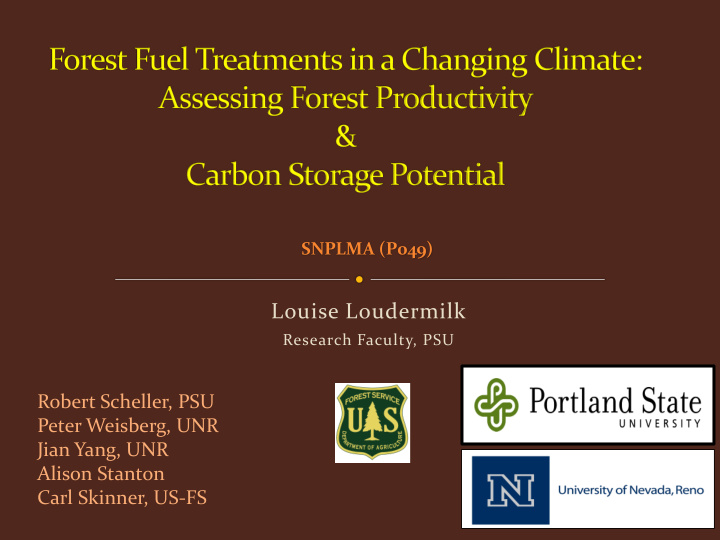



SNPLMA (P049) Louise Loudermilk Research Faculty, PSU Robert Scheller, PSU Peter Weisberg, UNR Jian Yang, UNR Alison Stanton Carl Skinner, US-FS
Fuel Climate Treatment Change Fire Forest
Does the LTB have C storage potential? Shifts from changing climate? or changing fire regimes? Net Carbon Time How is C distributed between the live, dead, and belowground pools?
Do fuel treatments increase C sequestration potential? If so, can we mitigate the effects ~ climate change? Strategic placement vs. area treated vs. rotation period
Project the long-term effects of: Climate change Wildfire Altered Ignition Patterns Fuel treatments on Forest Succession and Carbon Dynamics (gain or loss) in the entire LTB *
Climate Change Aboveground forest Soil Nutrients (C, N) Seed Dispersal Fire Forest Thinning http://www.landis-ii.org/
A2 Climate: 4° C increase in mean annual temp by 2100 Fire weather Tree growth & establishment Data source: Coats, R., J. Reuter, M. Dettinger, J. Riverson, G. Sahoo, G. Schladow, B. Wolfe, and M. Costa-Cabral. 2010. The effects of climate change on Lake Tahoe in the 21st century: meteorology, hydrology, loading and lake response. UC Davis.
Mean AG Live Biomass (g per m -2 ) Red fir 2° C (mean annual) Establishment ability Red fir, Lodgepole pine, Western white pine, Whitebark pine, Mtn. Hemlock
Base Climate A2 Climate
Live C (65%) Detrital C (5%) SOC (30%)
1) Long-Term Urban Core 2) Continued Fuel Treatment Intensity: ----- 15 & 30 yr. rotation pd. X Climate Scenarios Base Climate B1 A2 % Area 16% 12% 30% 42%
A2 Climate No Fuel Treatments Fuel Treatments 15 - RP Mean AG Live Biomass (g per m -2 )
A2 Climate Fuel Treatments 30-RP Fuel Treatments 15 - RP Mean AG Live Biomass (g per m -2 )
FT Scenario Change in Wildfire Continuous FT 15 RP ~50-75% reduction in area burned ~25-50% reduction in Long Term Urban Core area burned Both have similar reduction in Fire Severity!
Jian Yang, UNR Peter Weisberg, UNR
Ignition Density ~ Veg, Topo, Human factors, Climate, Lightning density Spatial Point Pattern Modeling & 2-step model averaging LANDIS-II LTB Model 25% - Lightning-caused fires Temporal Ignition No.s 75% - Human-caused fires Current & Future Climate
# ignitions / 100 km 2 / decade
A2 Climate (w/ign)
A2 w/ign & FTs A2 w/ign
Forest may remain C sink regardless of changes in climate “Landscape legacy” effects 2°+ C temperature ~ estab. of subalpine species Increased wildfire activity (CC) may accelerate impacts of climate change on forest C & species
Strategic placement (i.e., defensible space) vs. Area Treated vs. Intensity (15 vs. 30 RP) Mgt. may be able to mitigate for climate change Climate resilience ~ Fire resilience Caveat: direct impacts of CC Increased ignitions Fuel treatment effectiveness is unclear Intersection of treatment & wildfires
Recommend
More recommend